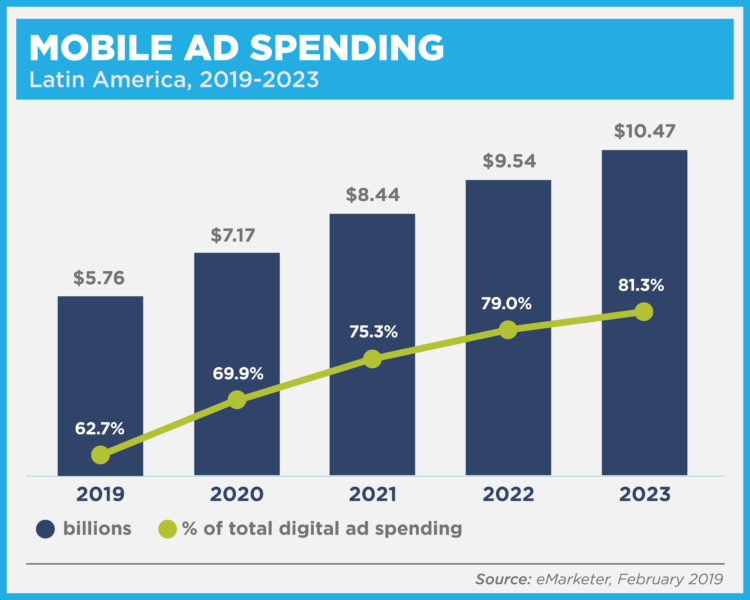Consumers' mobile phone habits are changing, and so are their expectations. They want relevance, convenience, and value that gives them experiences pertinent to not just where they are but also what they're doing.
Marketers must adapt fast to accommodate such changes. By weaving contextual and behavioral data into our mobile media buying decisions we can make them much more effective at driving the outcomes needed.
By next year consumers will spend more time with their mobile devices than they do with television. In fact, mobile is the the only major medium for which time spent is growing, according to an eMarketer report.
In Latin America, where I operate, mobile is expected to expand to $10.5 billion — or 81% of digital spend — within five years (see graphic). That's a big increase from this year's $5.76 billion, or 63% share of digital.

Some of the Best Practices
Marketers here and around the world are facing an imperative to tailor messaging to consumers on mobile. Here are some ways to get ahead:
Integrate on- and offline behavior.
- Marketers must constantly strategize around how offline and online can work together. Consumers' real-world habits offer powerful insights. Data from third parties, retailers (see below), and geo- location combine to form powerful tools.
Connect to DOOH.
- Digital-out-of-home advertising is another burgeoning opportunity to integrate the online and offline worlds. Digital-out-of-home can sync with, and amplify, mobile messaging to drive outcomes and improve efficiency.
Connect with retail shopping.
- Retailers gather a wealth of quality data that they and their marketing partners can use to measure the customer journey, including POS data, online behaviors, and responses that indicate purchase intent.
Add behavioral cues
- from consumer movements, and mix in third-party and POS data. The data help indicate the specific types of product(s) that interest specific consumers to inform marketers of the right messaging to send.
Improve m-commerce.
- More than 90% of retail purchases occur in the real world, but m-commerce represents hundreds of billions of dollars. In the U.S. alone, mobile commerce topped $208 billion last year, accounting for 40% of e- commerce sales, according to eMarketer. Meanwhile, 60% of merchants cite “ease of use for the consumer" as the top m-commerce challenge, according to a survey last June. Marketers can help retailers improve the user experience, then use data to continually make it more positive.
Make creative more relevant.
- Creative insertions need to be right for the mobile environment. Vertical ads, short-form videos, and push notifications all improve results. Programmatic creative optimizations facilitate dynamic personalization that add to campaigns' effectiveness.
Mobile Just Works
Multiple studies make the case that mobile, done well, improves outcomes.
This January, a Xaxis study in Mexico found that 20% of people visited a store the same day they were exposed to an ad. In Colombia, we found store visits could be attributed to mobile ad exposures, thereby increasing the ability to effectively retarget consumers.
A Retail System Research survey last year showed that retailers with better than average sales growth often use “mobile as the front edge of their consumer experience strategies." They are more likely than other retailers to provide functionality on mobile that improves on the desktop experience.
Using Technology to Enhance Data
The better the mobile experience, the more data marketers can gather and use. Retailers and brand marketers who share first-party data on consumers with their marketing technology partners can help those partners drive outcomes for them.
The best technology partners deploy artificial intelligence to enhance programmatic strategies that improve every aspect of a campaign. At Xaxis we leverage Copilot, our artificial intelligence technology, that uses machine learning to inform algorithms and helps build custom solutions to deliver on personalized outcomes.
Other emerging technologies are enabling voice search, which is done primarily on mobile. A survey last year found that mobile devices are the primary means for voice search for 64% of respondents (80% more than second-ranked smart speakers) .
Building Trust With Partners
Still, achieving success in mobile is about more than technology. It's about building trust through relationships with clients to help them reach consumers in the ways they want to be reached. It's about achieving real, measurable, and effective outcomes by combining proprietary and market data. And it's about the expertise to use best practices, then optimize.
Consumers don't use their mobile devices in a silo and neither should we. Like them, we need to make mobile an experience that gracefully integrates with what they are doing as they go throughout their days.
Relevance, value, and personalization will make happier customers. For retailers and brands, customers who value their experiences will become more engaged shoppers.




